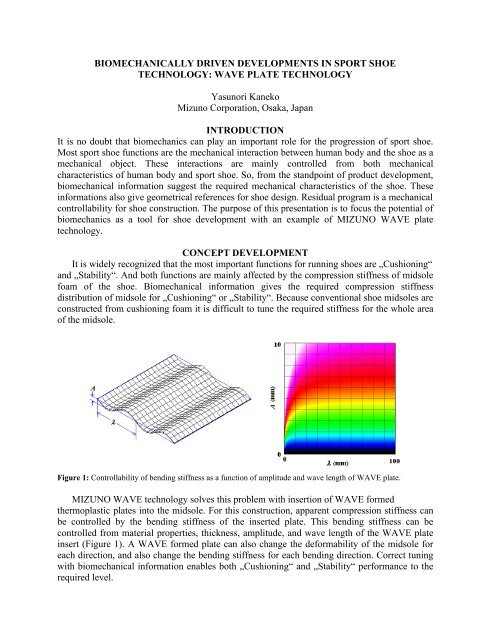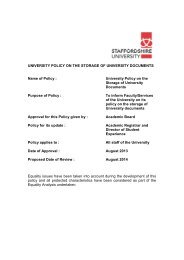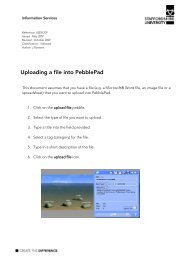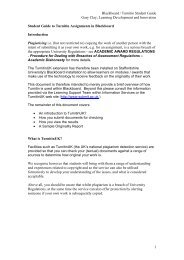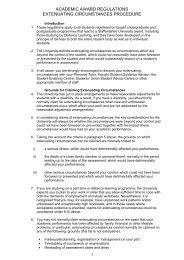BIOMECHANICALLY DRIVEN DEVELOPMENTS IN SPORT SHOE ...
BIOMECHANICALLY DRIVEN DEVELOPMENTS IN SPORT SHOE ...
BIOMECHANICALLY DRIVEN DEVELOPMENTS IN SPORT SHOE ...
You also want an ePaper? Increase the reach of your titles
YUMPU automatically turns print PDFs into web optimized ePapers that Google loves.
<strong>BIOMECHANICALLY</strong> <strong>DRIVEN</strong> <strong>DEVELOPMENTS</strong> <strong>IN</strong> <strong>SPORT</strong> <strong>SHOE</strong><br />
TECHNOLOGY: WAVE PLATE TECHNOLOGY<br />
Yasunori Kaneko<br />
Mizuno Corporation, Osaka, Japan<br />
<strong>IN</strong>TRODUCTION<br />
It is no doubt that biomechanics can play an important role for the progression of sport shoe.<br />
Most sport shoe functions are the mechanical interaction between human body and the shoe as a<br />
mechanical object. These interactions are mainly controlled from both mechanical<br />
characteristics of human body and sport shoe. So, from the standpoint of product development,<br />
biomechanical information suggest the required mechanical characteristics of the shoe. These<br />
informations also give geometrical references for shoe design. Residual program is a mechanical<br />
controllability for shoe construction. The purpose of this presentation is to focus the potential of<br />
biomechanics as a tool for shoe development with an example of MIZUNO WAVE plate<br />
technology.<br />
CONCEPT DEVELOPMENT<br />
It is widely recognized that the most important functions for running shoes are „Cushioning“<br />
and „Stability“. And both functions are mainly affected by the compression stiffness of midsole<br />
foam of the shoe. Biomechanical information gives the required compression stiffness<br />
distribution of midsole for „Cushioning“ or „Stability“. Because conventional shoe midsoles are<br />
constructed from cushioning foam it is difficult to tune the required stiffness for the whole area<br />
of the midsole.<br />
Figure 1: Controllability of bending stiffness as a function of amplitude and wave length of WAVE plate.<br />
MIZUNO WAVE technology solves this problem with insertion of WAVE formed<br />
thermoplastic plates into the midsole. For this construction, apparent compression stiffness can<br />
be controlled by the bending stiffness of the inserted plate. This bending stiffness can be<br />
controlled from material properties, thickness, amplitude, and wave length of the WAVE plate<br />
insert (Figure 1). A WAVE formed plate can also change the deformability of the midsole for<br />
each direction, and also change the bending stiffness for each bending direction. Correct tuning<br />
with biomechanical information enables both „Cushioning“ and „Stability“ performance to the<br />
required level.
PRODUCT DEVELOPMENT<br />
The MIZUNO WAVE technology was introduced in December 1997. The first products<br />
used a „PARALLEL“ WAVE (Figure 2A) sole in a cushioning category running shoe, and a<br />
„FAN-SHAPED“ WAVE (Figure 2C) sole in a stability category running shoe. For the<br />
development process, biomechanical information was used to determine the shape of the WAVE<br />
plate, and conventional biomechanical methods were used in functional testing. Now MIZUNO<br />
WAVE technology is expanded to baseball, volleyball, golf, and other kinds of sport shoes,<br />
designed according to available biomechanical information for each of the different sports.<br />
A B<br />
C D<br />
Figure 2: MIZUNO WAVE plate for (A) Light Weight Cushioning, (B) Cushioning, ( C)<br />
Stability, (D) Hyper Stability model of running shoe.<br />
DISCUSSION<br />
Biomechanics is not only valuable for the testing methodology of sport shoe functions. The<br />
most important effort for product development may be the development of design assisting<br />
tools. All of the biomechanical data should be processed as references for sport shoe design.<br />
Good sport shoe design should match the shoe and human body in mechanical and kinematic<br />
features.


